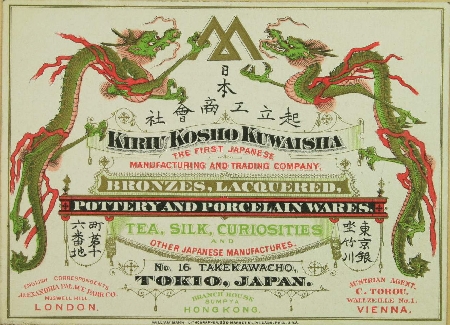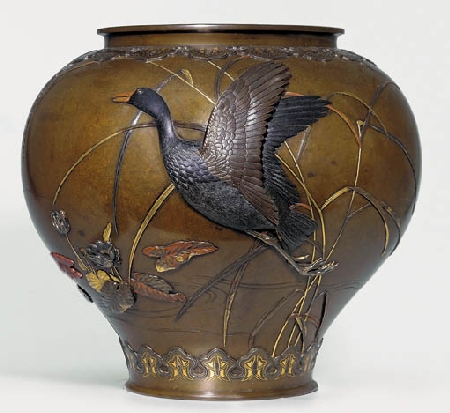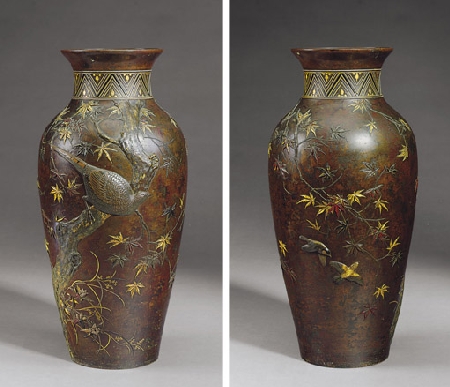The Kiryu Kosho Kaisya 起立工商会社 (1873-1891)
 The Kiryu Kosho Kaisha 起立工商会社 was founded in 1873 by the Meiji government after the great success of the Japanese exhibit of the Vienna World Exhibition of 1873.
The Kiryu Kosho Kaisha 起立工商会社 was founded in 1873 by the Meiji government after the great success of the Japanese exhibit of the Vienna World Exhibition of 1873.
The Kiryu Kosho Kaisha 起立工商会社 founded a New York branch as early as 1877 and actively sold Japanese crafts. After its disappearance in 1891, Yamanaka became the leading dealer in the United States, operating branches in New York, Boston, Chicago, Atlantic City, Newport, and Bar Harbor. In Boston, another pioneer Japanese businessman, Matsuki Bunkyo, opened his store in 1893 and became an important dealer.
Their label described themselves as below ;
Our firm, Kiriu Kosho Kuwaisha, (The First Japanese Manufacturing and Trading Company,) is established for the ppurpose of encouraging the Japanese industries, and of promoting the greatest possible perfection therein.
Kan Gio Rio, (the Bureau of Industry,) fully co-operates with our firm, and we are authorized by that Bureau to sell all the Teas they manufacture.
Fantacy and useful articles, of the finest as well as the cheapest quality, sold at the lowest possible prises, Wholesale and Retail.
Orders by mail promptly attended to.
 Incense Burner (Japanese: koro) by the artist Suzuki Chokichi (here using his art name Kako) displayed at the 1878 Paris Universal Exhibition. The koro was bought by Siegfried Bing, a prominent Parisian dealer who later offered it to the V&A. The V&A paid Bing the astonishing sum of £1,568 7s.2d. for the incense burner and needed special permission from the Treasury to make such a major purchase.The Kiryu Kosho Kaisha was known at the time, in antique and naive transliteration, as 'Kiriukoshio Guaishia'; the correct reading the company's name, with Kiryu rather than Kiritsu, has been established from early engravings and photographs.
Incense Burner (Japanese: koro) by the artist Suzuki Chokichi (here using his art name Kako) displayed at the 1878 Paris Universal Exhibition. The koro was bought by Siegfried Bing, a prominent Parisian dealer who later offered it to the V&A. The V&A paid Bing the astonishing sum of £1,568 7s.2d. for the incense burner and needed special permission from the Treasury to make such a major purchase.The Kiryu Kosho Kaisha was known at the time, in antique and naive transliteration, as 'Kiriukoshio Guaishia'; the correct reading the company's name, with Kiryu rather than Kiritsu, has been established from early engravings and photographs.
See Illustrated Catalogue of the Japanese Art Exhibition (Boston, 1883), reproduced in Hida Toyojiro, Meiji no yushutsu kogei zuan: Kiryu Kosho Kaisha no rekishi [Meiji Period Design Sketches for Export Crafts: The History of the Kiritsu Kosho Kaisha] (Nihon moyo zushu [Collection of Japanese designs] series, Kyoto, Kyoto Shoin, 1998), p. 193, fig. 11
With a few exceptions these vases are either signed Kako (Suzuki Chokichi's art name) or, more rarely, Kiritsu Kiryu Kaisha, in either case under a double mountain mark, and are between about 10 and 12 inches in height.
For further examples see Oliver Impey and Malcolm Fairley (eds.), Meiji no Takara: Treasures of Imperial Japan (The Nasser D.Khalili Collection of Japanese Art, London, Kibo Foundation, 1995), volume 2, part 1 (Metalwork), cat. no. 5; Joe Earle, Splendors of Meiji: Treasures of Imperial Japan, Masterpieces from the Khalili Collection (St. Petersburg, Florida, Broughton International Publications, 1999), cat. no. 6 (an example with a lid) and Joe Earle, Flower Bronzes of Japan (London, 1995), plates 84, 86, 87 and 88 (this last in the Victoria and Albert Museum); and Christie's London, Japanese Works of Art (16 June 1998), lot 273
The designs are mostly based on one of 1,969 drawings dating from between 1877 and 1890, commissioned by the company from various artists and now preserved in Tokyo University of Arts.
Hida Toyojiro, Kiritsu Kosho Kaisha kogei shitazushu: Meiji no yushutsu kogei zuan [Kiritsu Kosho Kaisha, the first Japanese manufacturing and trading company: designs for export crafts] (Kyoto, Kyoto Shoin, 1987) and Hida Toyojiro, Meiji no yushutsu kogei zuan: Kiryu Kosho Kaisha no rekishi [Meiji Period Design Sketches for Export Crafts: The History of the Kiritsu Kosho Kaisha] (Nihon moyo zushu [Collection of Japanese designs] series, Kyoto, Kyoto Shoin, 1998)
The Kiryu Kosho Kaisya comissioned works from the leading craftpeople but presented the artisans with designs for the decoration and forms of the pieces they ordered. The company went out of the business in 1891. Perhaps because it was a semi governmental organization, it lacks a solid grasp of the market and was the first of the brokerage firms to close its door. They tried to sell their inventory in New York and Paris at the time, but were unable to do so because it was already quite outdated.
Suzuki Chokichi (1848-1919)
 Bronze Jar signed Kako (Suzuki Kokichi), circa 1881-3. With pale brown patination, of wide baluster form with a low footring and squared-off lip, the decoration bounded above and below by bands of Chinese style lappet ornament inlaid with stylised butterfly motifs, the main decoration consisting of a moorhen and a kingfisher flying above a pond or stream with lotus plants and grasses, the decoration executed in shibuichi, copper, gold and silver in a variety of patinations with some engraved details, signed on the recessed base in stamped characters Kako beneath the double mountain mark of the Kiryu Kosho Kaisha
10½in. (26.6cm.) high. Sold at GBP 35,250 at Christies' on 20 June 2001. Suzuki Chokichi (1848-1919) in association with the Kiryu Kosho Kaisha, a semi-official global trading company set up in the wake of the Vienna Exposition of 1873. While Chokichi apparently supervised the casting process, the elaborate soft-metal decoration was carried out by other craftsmen who had earlier trained as makers of sword-fittings; the names of two of these specialists, Sugiura Yukinari and his brother Sugiura Yukimune, are known from two bronzes in the Khalili collection. These bronzes are rightly regarded as a triumphant combination of two of the principal metalworking traditions of pre-modern Japan: bronzecasting and chiselling in gold, silver and a variety of copper alloys.
Bronze Jar signed Kako (Suzuki Kokichi), circa 1881-3. With pale brown patination, of wide baluster form with a low footring and squared-off lip, the decoration bounded above and below by bands of Chinese style lappet ornament inlaid with stylised butterfly motifs, the main decoration consisting of a moorhen and a kingfisher flying above a pond or stream with lotus plants and grasses, the decoration executed in shibuichi, copper, gold and silver in a variety of patinations with some engraved details, signed on the recessed base in stamped characters Kako beneath the double mountain mark of the Kiryu Kosho Kaisha
10½in. (26.6cm.) high. Sold at GBP 35,250 at Christies' on 20 June 2001. Suzuki Chokichi (1848-1919) in association with the Kiryu Kosho Kaisha, a semi-official global trading company set up in the wake of the Vienna Exposition of 1873. While Chokichi apparently supervised the casting process, the elaborate soft-metal decoration was carried out by other craftsmen who had earlier trained as makers of sword-fittings; the names of two of these specialists, Sugiura Yukinari and his brother Sugiura Yukimune, are known from two bronzes in the Khalili collection. These bronzes are rightly regarded as a triumphant combination of two of the principal metalworking traditions of pre-modern Japan: bronzecasting and chiselling in gold, silver and a variety of copper alloys.
Sugiura Yukimune / Sugiura Yukinari
 Bronze and Mixed-Metal Vase,
Meiji period (late 19th century), stamped on the base Kiryu Kosho Kaisha sei beneath the "double-mountain" mark of the company, signed on the side Yukimune horu kore (Sugiura Yukimune) and sealed Koichi zu and Sugiura. The vase worked in high relief with a pheasant perched on the gnarled trunk of a maple tree by autumn plants and grasses and two small birds in flight, the details of the bird's feathers intricately carved and embellished with copper, gold, silver and shakudo, the leaves patinated in autumn colors of red, brown, gold and shakudo, the trunk of the tree carved and chiselled to resemble the rough texture of bark, the neck decorated with a band of lappets contaning half florets rendered in gold, silver and shakudo; signature on shakudo reserve. 33 7/8in. (86cm.) high. Sold at $ 85,000 at Christies' on 18 Sep 2007.Sugiura Yukimune and his older brother Yukinari studied metalwork and carving sword-fittings in the tradition of Yokoya Somin (1670-1733). Both Yukimune and Yukinari exhibited at the Paris Exposition of 1900.
Bronze and Mixed-Metal Vase,
Meiji period (late 19th century), stamped on the base Kiryu Kosho Kaisha sei beneath the "double-mountain" mark of the company, signed on the side Yukimune horu kore (Sugiura Yukimune) and sealed Koichi zu and Sugiura. The vase worked in high relief with a pheasant perched on the gnarled trunk of a maple tree by autumn plants and grasses and two small birds in flight, the details of the bird's feathers intricately carved and embellished with copper, gold, silver and shakudo, the leaves patinated in autumn colors of red, brown, gold and shakudo, the trunk of the tree carved and chiselled to resemble the rough texture of bark, the neck decorated with a band of lappets contaning half florets rendered in gold, silver and shakudo; signature on shakudo reserve. 33 7/8in. (86cm.) high. Sold at $ 85,000 at Christies' on 18 Sep 2007.Sugiura Yukimune and his older brother Yukinari studied metalwork and carving sword-fittings in the tradition of Yokoya Somin (1670-1733). Both Yukimune and Yukinari exhibited at the Paris Exposition of 1900.
Yamamoto Koichi
Yamamoto Koichi was responsible for the design. Typically, Koichi would produce a design to be cast in bronze, often supervised by Suzuki Chokichi (1848-1919), another master craftsman employed by the Kiryu Kosho Kaisha. The intricate carving of the mixed-metal decoration was left to other artists like Yukimune. In this manner the Kiryu Kosho Kaisha produced many examples of bronzes that represented a successful combination of two of the principal metalworking traditions of pre-modern Japan: bronzecasting and chiselling in gold, silver and a variety of copper alloys.
 Top
Top Site Map
Site Map References
References About Me
About Me